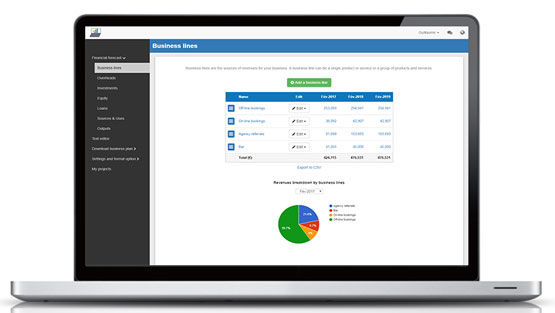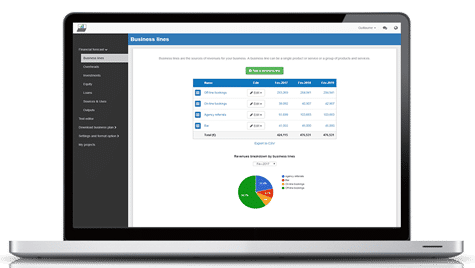How to open a donut shop?
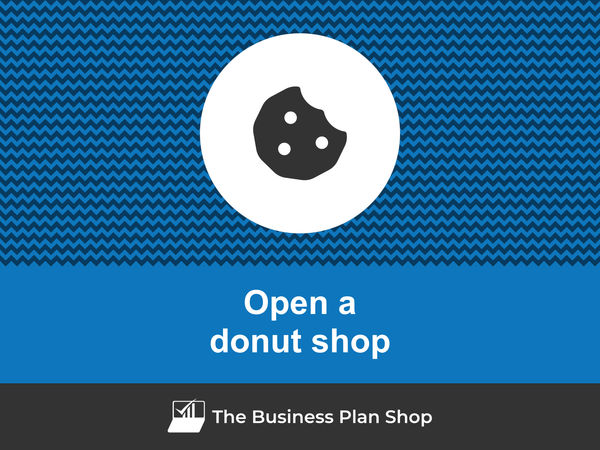
There's no doubt that starting a donut shop requires a lot of work, but with expert planning, you'll be well on your way to creating a profitable business venture.
This guide will give you a low down on all of the major steps involved, from choosing a legal structure to creating a financial forecast and registering your business.
We will also walk you through the process of checking whether or not your idea can be viable given market conditions.
Let's embark on this exciting journey together!
What is the business model of a donut shop?
Before thinking about starting a donut shop, you'll need to have a solid understanding of its business model (how it generates profits) and how the business operates on a daily basis.
Doing so will help you decide whether or not this is the right business idea for you, given your skillset, personal savings, and lifestyle choices.
Looking at the business model in detail will also enable you to form an initial view of the potential for growth and profitability, and to check that it matches your level of ambition.
The easiest ways to acquire insights into how a donut shop works are to:
- Speak with donut shop owners
- Undertake work experience with a successful donut shop
- Participate in a training course
Speak with donut shop owners
Talking to seasoned entrepreneurs who have also set up a donut shop will enable you to gain practical advice based on their experience and hindsight.
Learning from others' mistakes not only saves you time and money, but also enhances the likelihood of your venture becoming a financial success.
Undertake work experience with a successful donut shop
Gaining hands-on experience in a donut shop provides insights into the day-to-day operations, and challenges specific to the activity.
This firsthand knowledge is crucial for effective planning and management if you decide to start your own donut shop.
You'll also realise if the working hours suit your lifestyle. For many entrepreneurs, this can be a "make or break" situation, especially if they have children to look after.
First-hand experience will not only ensure that this is the right business opportunity for you, but will also enable you to meet valuable contacts and gain a better understanding of customer expectations and key success factors which will likely prove advantageous when launching your own donut shop.
Participate in a training course
Undertaking training within your chosen industry is another way to get a feel for how a donut shop works before deciding to pursue a new venture.
Whichever approach you go for to gain insights before starting your donut shop, make sure you familiarise yourself with:
- The expertise needed to run the business successfully (do you have the skills required?)
- How a week of running a donut shop might look like (does this fit with your personal situation?)
- The potential turnover of your donut shop and long-term growth prospects (does this match your ambition?)
- The likely course of action if you decide to sell the company or retire (it's never too early to consider your exit)
At the end of this stage, you should be able to decide whether opening a donut shop is the right business idea for you given your current personal situation (skills, desires, money, family, etc.).
Assembling your donut shop's founding team
The next step to opening your donut shop is to think about the ideal founding team, or to decide to go in alone.
Starting and growing a successful business doesn't have to be a solo journey and setting up a donut shop with several co-founders is generally easier. The business benefits from a management team with a wider skillset, decisions are made together, and the financial risk is shared among the partners, making the journey more collaborative and less daunting.
But, running a business with several partners brings its own challenges. Disagreements between co-founders are quite common, and these can pose risks to the business. That's why it's crucial to consider all aspects before starting your own business.
We won't go into too much detail here, as this is a complex topic that deserves its own guide, but we do recommend that you ask yourself the following questions:
- What is the ideal number of co-founders for this venture?
- Are you on the same wavelength as your potential partners in terms of vision and ambition?
- How will you deal with potential failure?
Let's look at each of these questions in more detail.
What is the ideal number of co-founders for this venture?
To answer this question you will need to consider the following:
- What skills do you need to run the business? Are you lacking any?
- How much startup capital do you need? How much do you have?
- How are key decisions going to be made? - It is usually advisable to have an odd number of partners (or a majority shareholder) to help break the tie.
Put simply, your co-founders contribute skills, capital, or both. Increasing the number of partners becomes advantageous when there is a deficiency in either of these resources.
Are you on the same wavelength as your potential partners in terms of vision and ambition?
Your business partners should share the same short and long-term vision, be it business expansion or social responsibility, to avoid future frustrations and simplify decision-making. Different views are natural, but alignment is ideal.
In any case, you should think of having an exit mechanism in place in case one of the partners wants to move on.
How will you deal with potential failure?
We wish you nothing but success when starting up and growing your donut shop, but it's always wise to have a backup in case things don't go as planned.
How you deal with a potential failure can vary significantly based on the relationship you have with your business partner (close friend, spouse, ex-colleague, etc.) and the personal circumstances of each of you.
For instance, starting a business with your spouse might seem appealing, but if it doesn't succeed, you risk losing 100% of the household income at once, which could be stressful.
Similarly, going into a partnership with a friend can put pressure on the friendship in the event of failure or when you need to make difficult decisions.
There is no wrong answer, but it is essential to carefully evaluate your options before starting up to ensure you're well-prepared for any potential outcomes.
Conducting market research for a donut shop
The next step in launching a donut shop is to carry out market research. Let's take a look at what this involves.
The objectives of market research
The objective here is very simple: to assess the level of demand for your business and whether there is an opportunity for it to thrive in your chosen location.
The first step will be to check that the market is not saturated with competing offers and that there is room for a new player: your donut shop.
Your market analysis will also help you identify a concept and market positioning that has every chance of being successful in your target market, thereby helping increase your business's chances of success.
Carrying out market research for your donut shop will also enable you to better understand the expectations of your future customers and the most effective ways to communicate with them in your marketing plan.
Analyse key trends in the industry
Your market research should start with an industry analysis in order to gain a good understanding of the main players and current trends in your sector.
Once you've delved into the current state of the market, it will be time to assess what proportion of your target market can be seized by your donut shop. To do this, you will need to consider both the demand and supply side of the market.
Assess the demand
After checking out the industry, let's shift our focus to figuring out what your potential customers want and how they like to buy.
A classic mistake made by first-time entrepreneurs is to assess demand on the global or national market instead of concentrating on their target market. Only the market share that can be captured by your company in the short term matters.
Your demand analysis should seek to find answers to the following questions:
- Who are your target customers?
- How many are there?
- What are their expectations?
- What are their buying habits?
- How much budget do they have?
- What are the different customer segments and their characteristics?
- What are the main distribution channels and means of communication for reaching each segment?
The aim of the demand analysis is to identify the customer segments that could be targeted by your donut shop and what products and services you need to offer to meet their expectations.
Analyse the supply side
You will also have to familiarize yourself with the competing donut shops on the market targeted by your future business.
Amongst other things, you’ll need to ask yourself:
- Who are the main competitors?
- How many competitors are already present?
- Where are they located?
- How many people do they employ?
- What is their turnover?
- How do they set their prices?
- Are they small independent businesses or national players?
- Do they seem to be in difficulty or are they flourishing?
- What is their market positioning?
- What types of products and services do they offer?
- What do customers seem to like about them?
The aim of the competitive analysis is to identify who your competitors will be and to gather information that will help you find a differentiating commercial positioning (more on that later in this guide).
Regulations
Conducting market research is also an opportunity to look at the regulations and conditions required to do business.
You should ask yourself the following questions:
- Do you need to have a specific degree to open a donut shop?
- Do you need specific licences or permits?
- What are the main regulations applicable to your future business?
Given that your project is at an early stage, your focus should be to clear that there are no roadblocks from a regulatory standpoint before you deep dive into the planning process.
Once your project is more advanced, you will have the opportunity to talk about regulation more in-depth with your lawyer.
Concluding your market research
By the time your market research is completed, you should have either:
- Pinpointed an untapped business opportunity
- Or arrived at the realisation that the market is saturated, prompting the search for alternative business ideas or models.
If the conclusion is that there is an opportunity in the market to cater to one or more customer segments currently overlooked by competitors, that's great!
Conversely, if you come to the conclusion that the market is already saturated, don’t panic! The good news is that you won’t spend several years working hard on a project that has little chance of success. There is no shortage of business ideas either - at The Business Plan Shop, we have identified more than 1,300 potential business ideas!
How should I position my donut shop on the market?
The next step to start your donut shop is to define precisely the market positioning your company will adopt in order to capitalise on the opportunity identified during your market research.
Market positioning refers to the place your product and service offering occupies in customers' minds and how they differ from the competition. Being perceived as a low-cost solution, for example.
To find a concept and a market positioning that will resonate with your customers, you need to address the following issues:
- How can you differentiate yourself from your competitors?
- Do you have the option of joining a franchise to reduce risk?
- Is it better to start or buy a donut shop already in operation?
- How will you validate your concept and market positioning before investing in the business?
Let's look at these aspects in more detail.
How can you differentiate yourself from your competitors?
Opening a donut shop means starting with a major disadvantage compared with competitors already active on the market.
While you will have to create everything from scratch, your competitors already have everything in place.
Your competitors' teams know the business well, whereas yours has only just been recruited, their customers are loyal and they benefit from word of mouth that you don't yet have.
So you're going to need a solid plan to succeed in taking market share from your competitors and making your mark.
There are a number of aspects to consider in order to try to avoid direct confrontation if possible:
- Can you target a different customer base than your competitors?
- Can you offer products or services that are different from or complementary to what your competitors already sell?
- How will your competitors react to your donut shop entering their market?
- Can you build a sustainable competitive advantage that will enable you to compete with your current and future competitors?
Do you have the option of joining a franchise to reduce risk?
A proven way of reducing the risk of your business venture is to join a franchise.
Joining a donut shop franchise means you don't have to start from scratch. You benefit from the brand recognition of a group and support with operational processes, relations with suppliers, recruitment, etc.
On the flip side, being part of a franchise will restrict your personal freedom, and you'll have to pay an entry fee and an annual royalty (typically a percentage of your sales).
Nevertheless, where possible, starting up as a franchise is generally a good way of reducing risks, especially if you're up against competitors with well-known brands.
Please note, however, that franchising opportunities vary from country to country and region to region, so there is no guarantee that you'll be able to find a franchise.
Is it better to start or buy a donut shop already in operation?
The other alternative to setting up a new independent business is to buy out and take over a donut shop already in operation.
Here too, a takeover is a good way of reducing the risk of your project compared with a pure start-up.
Taking over a business has two enormous advantages over setting up a new one: you start out on an equal footing with your competitors since you take over the team and the customer base, and you don't increase the supply on the market enabling you to maintain the existing balance on the market where the business operates.
However, as with franchising, the capital requirements for a takeover are higher because the business will have to be bought from its previous owners.
How will you validate your concept and market positioning before investing in the business?
However you decide to set up your business, you will need to ensure that there is a good fit between what you sell and what customers are looking to buy.
To do this, you'll need to meet your target customers to present your products or services and check that they meet their expectations.
Deciding where to base your donut shop
The next step to opening a donut shop is deciding where you want to set up your business.
Choosing the right location for your business is like finding the perfect stage for a play. Without it, your business may lack the spotlight it deserves.
Whilst there is no “perfect” location for your donut shop, one that meets as many of the following factors as possible could be ideal:
- Visibility and foot traffic - A donut shop relies on foot traffic for customers, so a highly visible location with a lot of foot traffic is crucial for success.
- Parking space, road and public transport accessibility - Customers may be more likely to visit a donut shop if it is easily accessible by car, public transportation, or walking. Having ample parking space is also important for convenience.
- Proximity to target customers - A donut shop should be located near its target customers, such as in a busy shopping area or near schools or offices.
- Competitor presence - It's important to research the competition in the area to ensure there is enough demand for another donut shop and to differentiate from other similar businesses.
- Efficient logistics - For industrial businesses, such as manufacturers or makers, efficient logistics is crucial for sourcing ingredients and supplies and delivering finished products to customers.
- Storage space - A donut shop will need adequate storage space for ingredients, equipment, and finished products. This is especially important for businesses that produce a large volume of donuts.
- Availability of skilled labor - For industrial businesses, skilled labor is necessary for production and for maintaining quality and consistency in the products.
- Easy access to main roads - This is important for businesses that rely on deliveries or for customers to easily access the location.
- Climate and soil quality - For agricultural businesses, the climate and soil quality can greatly impact the growth and quality of ingredients used in donuts.
- Adequate infrastructure - This is important for businesses that require certain infrastructure, such as a commercial kitchen or specific equipment, to operate effectively.
- Premises layout - For hospitality businesses, such as restaurants or hotels, a well-designed and functional layout is important for creating a pleasant and efficient experience for customers.
- Space to grow - For e-commerce or online businesses, having physical space to expand and grow as the business grows is important for scalability and meeting increasing demand.
- Demographic of local population - For transportation businesses, understanding the demographics of the local population can help determine the target market and potential demand for transportation services.
This list is obviously not exhaustive and will have to be adapted to the particularities of your project.
Once you’ve considered the factors above, it’s important to think about the budget that your startup has at its disposal. You’ll need to find a location that meets your business requirements but is affordable enough, especially short-term.
If you opt for renting instead of buying your premises, make sure to take into account the terms of the lease, including aspects such as the duration, rent increase, renewal, and so on.
The lease contractual terms vary greatly from country to country, so be sure to check the terms applicable to your situation and have your lease reviewed by your lawyer before signing.
Choosing your donut shop's legal form
The next step to open a donut shop is to choose the legal form of your business.
The legal form of a business simply means the legal structure it operates under. This structure outlines how the business is set up and defines its legal obligations and responsibilities.
Why is your donut shop's legal form important?
Choosing the legal form for your donut shop is an important decision because this will affect your tax obligations, your personal exposure to risk, how decisions are made within the business, the sources of financing available to you, and the amount of paperwork and legal formalities, amongst other things.
The way you set up your business legally will impact your taxes and social contributions, both at a personal level (how much your income is taxed) and at the business level (how much the business's profits are taxed).
Your personal exposure to risk as a business owner also varies based on the legal form of your business. Certain legal forms have a legal personality (also called corporate personality), which means that the business obtains a legal entity which is separate from the owners and the people running it. To put it simply, if something goes wrong with a customer or competitor, for example, with a corporate personality the business gets sued, whereas without it is the entrepreneur personally.
Similarly, some legal forms benefit from limited liability. With a limited liability the maximum you can lose if the business fails is what you invested. Your personal assets are not at risk. However, not all structures protect you in such a way, some structures may expose your personal assets (for example, your creditors might try to go after your house if the business incurs debts and then goes under without being able to repay what it owed).
How decisions are made within the business is also influenced by the legal form of your donut shop, and so is the amount of paperwork and legal formalities: do you need to hold general assemblies, to produce annual accounts, to get the accounts audited, etc.
The legal form also influences what sources of financing are available to you. Raising capital from investors requires having a company set up, and they will expect limited liability and corporate personality.
What are the most common legal structures?
It's important to note that the actual names of legal structures for businesses vary from country to country.
But they usually fall within two main types of structures:
- Individual businesses
- Companies
Individual businesses
Individual businesses, such as sole traders or sole proprietorships, are legal structures with basic administrative requirements.
They primarily serve self-employed individuals and freelancers rather than businesses with employees.
The main downside of being a sole trader is that there's usually no legal separation between the business and the person running it. Everything the person owns personally is tied up with the business, which can be risky.
This means that if there are problems or the business goes bankrupt, the entrepreneur's personal assets could be taken by creditors. So, there's a risk of personal liability in case of disputes or financial issues.
It is also not possible to raise equity from investors with these structures as there is no share capital.
Despite the downsides, being a sole proprietorship has some advantages. There is usually very little paperwork to get started, simpler tax calculations and accounting formalities.
Companies
Companies are all rounders which can be set up by one or more individuals, working on their own or with many employees.
They are recognized as a distinct entity with their own legal personality, and the liability is usually limited to the amount invested by the owners (co-founders and investors). This means that you cannot lose more than you have invested in the business.
This separation ensures that in legal disputes or bankruptcy, the company bears primary responsibility, protecting the personal assets of the founder(s) and potential investor(s).
How should I choose my donut shop's legal structure?
Deciding on the legal structure is usually quite straightforward once you know how many co-founders you'll have, whether you'll have employees, and the expected revenues for the business.
A good business idea will be viable whatever the legal form you choose. How businesses are taxed changes every year, therefore one cannot rely on specific tax benefits tied to a particular structure when deciding to go into business.
One easy way to proceed is to take note of the legal structures used by your top five competitors, and assume you're going with the most commonly chosen option. Once your idea is mature and you're prepared to formally register the business, you can validate this assumption with a lawyer and an accountant.
Can I switch my donut shop's legal structure if I get it wrong?
You can switch your legal setup later on, even if it involves selling the old one to a new entity in some cases. However, this comes with extra costs, so it's better to make the right choice from the beginning if you can.
Assess the startup costs for a donut shop
The next step in creating a donut shop involves thinking about the equipment and staff needed for the business to operate.
After figuring out what you need for your business, your financial plan will reveal how much money you'll need to start and how much you might make (check below for more details).
Because every venture is distinctive, providing a reliable one-size-fits-all budget for launching a donut shop without knowing the specifics of your project is not feasible.
Each project has its own particularities (size, concept, location), and only a forecast can show the exact amount required for the initial investment.
The first thing you'll need to consider is the equipment and investments you'll need to get your business up and running.
Startup costs and investments to launch your donut shop
For a donut shop, the initial working capital requirements (WCR) and investments could include the following elements:
- Donut making equipment: This includes items such as mixers, fryers, and dough cutters. These are essential for creating the donuts and should be factored into your expenditure forecast.
- Refrigeration units: Donut shops typically require refrigeration units to store ingredients and finished products. These can include walk-in coolers, display cases, and freezers. Make sure to include the cost of purchasing and maintaining these units in your forecast.
- Furniture and fixtures: Your donut shop will need tables, chairs, and other furniture for customers to sit and enjoy their treats. You may also need shelving units, display stands, and other fixtures to showcase your donuts. These items may seem small, but they can add up in terms of cost, so be sure to include them in your forecast.
- Point of sale system: A modern point of sale (POS) system is essential for any business, including a donut shop. This includes a cash register, credit card processing terminal, and possibly a computer or tablet. These systems can be expensive, so make sure to budget for them in your expenditure forecast.
- Delivery vehicle: If you plan on offering delivery services, you may need to purchase a vehicle specifically for this purpose. This can include a van, truck, or even a bicycle, depending on the size of your operation. Don't forget to include the cost of purchasing and maintaining this vehicle in your forecast.
Of course, you will need to adapt this list to your business specificities.
Staffing plan of a donut shop
In addition to equipment, you'll also need to consider the human resources required to run the donut shop on a day-to-day basis.
The number of recruitments you need to plan will depend mainly on the size of your company.
Once again, this list is only indicative and will need to be adjusted according to the specifics of your donut shop.
Other operating expenses for a donut shop
While you're thinking about the resources you'll need, it's also a good time to start listing the operating costs you'll need to anticipate for your business.
The main operating costs for a donut shop may include:
- Staff Costs: This includes the salaries and wages of all employees, including both front-of-house staff such as cashiers and baristas, and back-of-house staff such as bakers and kitchen assistants.
- Ingredient Costs: As a donut shop, your main expense will be the cost of ingredients such as flour, sugar, and oil. These costs can fluctuate depending on the market prices.
- Rent and Utilities: You will need a physical space to operate your donut shop, so rent will be a monthly expense. You will also need to cover utilities such as electricity, water, and gas.
- Marketing and Advertising: In order to attract customers, you will need to invest in marketing and advertising efforts, such as flyers, social media ads, and collaborations with other local businesses.
- Equipment Maintenance: Your donut shop will require equipment such as mixers, ovens, and fryers. These will need regular maintenance to ensure they are functioning properly.
- Packaging and Supplies: Donuts need to be packaged and presented to customers in an attractive way. This will require the purchase of packaging materials, such as boxes and bags, as well as other supplies like napkins and cups.
- Accountancy Fees: In order to keep your finances in order, you may need to hire an accountant to help with bookkeeping, tax preparation, and other financial matters.
- Insurance Costs: It is important to have insurance coverage for your donut shop in case of accidents, liability claims, or other unforeseen events.
- Software Licenses: You may need to invest in software licenses for programs such as point-of-sale systems, accounting software, and scheduling tools.
- Banking Fees: As a business, you will have to pay fees for banking services such as checking accounts, credit card processing, and cash handling.
- Cleaning and Sanitation: Maintaining a clean and sanitary environment is crucial for food businesses. This includes the cost of cleaning supplies and potentially hiring a cleaning service.
- Training and Development: In order to provide the best service and products, you may need to invest in training and development for your staff, such as workshops or classes on new techniques or recipes.
- Taxes and Licenses: As a business, you will have to pay taxes and obtain necessary licenses and permits to operate your donut shop.
- Delivery and Transportation: If you offer delivery services or need to transport ingredients or supplies, you will need to include the cost of gas, vehicle maintenance, and potentially hiring delivery drivers.
- Waste Management: Donut shops produce waste, so you will need to consider the cost of waste management services, such as garbage collection and recycling.
Like for the other examples included in this guide, this list will need to be tailored to your business but should be a good starting point for your budget.
Creating a sales & marketing plan for your donut shop
The next step to start a donut shop is to think about how you are going to attract and retain customers.
You need to ask yourself the following questions:
- What actions can be leveraged to attract as many customers as possible?
- How will you then retain customers?
- What resources do you need to allocate for each initiative (human and financial)?
- How many sales and what turnover can you expect to generate in return?
How you will attract and retain customers depends on your ambition, the size of your startup and the nature of your exact concept, but you could consider the following initiatives.
Your sales forecast may also be influenced by seasonality related to your business type, such as fluctuations during busy holiday periods, and your competitive environment.
How do I build my donut shop financial forecast?
Let's now look at the financial projections you will need to prepare in order to open a donut shop.
What is a donut shop's financial projection?
Your financial forecast will help you budget your project so that you can evaluate:
- Its expected sales and growth potential
- Its expected profitability, to ensure that the business will be viable
- Its cash generation and financing requirements
Making your financial forecast is the only way to determine the amount of initial financing required to create your donut shop.
There are lots of business ideas out there, but very few of them are viable, and making a financial forecast is the only way to ensure that your project makes economic and financial sense.
Creating a donut shop financial projection is an iterative process, as you'll need to refine your figures as your business idea matures.
You'll start with a first high-level version to decide whether or not to continue working on the project.
Then, as your project takes shape, your forecasts will become increasingly accurate. You'll also need to test different assumptions to ensure that your idea of starting a donut shop holds up even if your trading environment deteriorates (lower sales than expected, difficulties in recruiting, sudden cost increases or equipment failure problems, for example).

Your financial forecast will be part of your overall business plan, which we'll look at in more detail later. Your financial partners will use your business plan to decide if they want to finance you.
Once you've launched your business, you can compare your actual accounting figures with your forecasts, to analyze where the discrepancies come from, and then update your forecasts to maintain visibility over your future cash flows.
Financial forecasts are, therefore, a financial management tool that will be with you throughout the life of your company.
What does a financial projection look like?
Your donut shop forecast will be presented using the following financial tables.
The projected P&L statement
The projected P&L statement for a donut shop shows how much revenue and profits your business is expected to generate in the future.
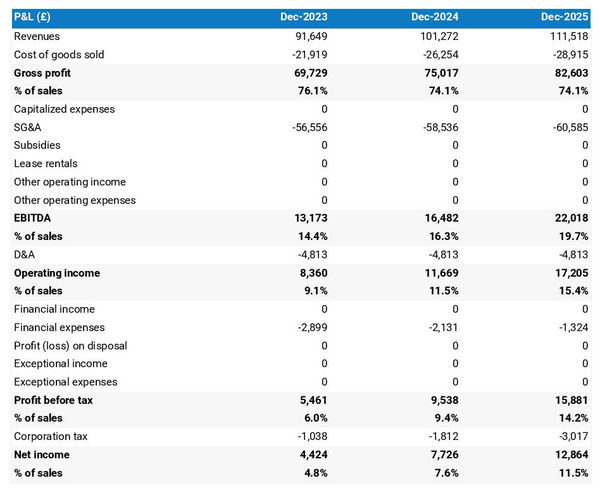
The projected balance sheet of your donut shop
Your donut shop's projected balance sheet provides a snapshot of your business’s financial position at year-end.
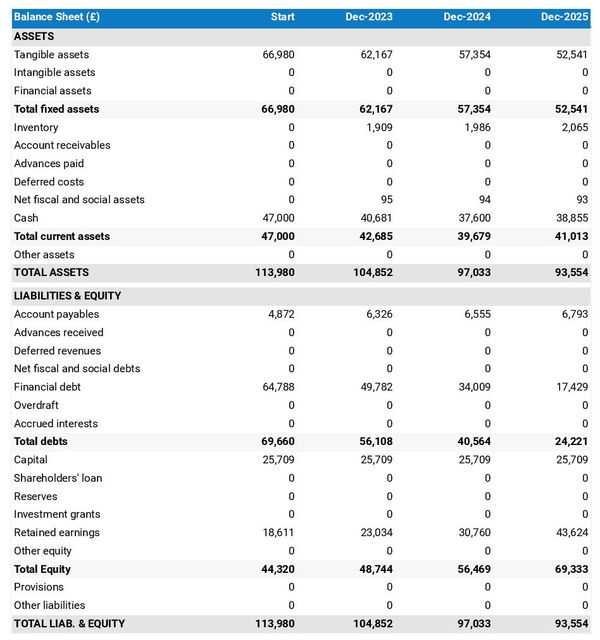
The cash flow forecast
A projected cash flow statement for a donut shop is used to show how much cash the business is expected to consume or generate in the years to come.
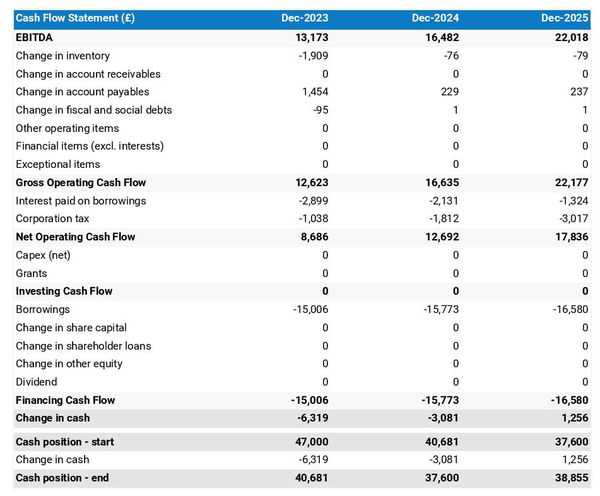
Which solution should you use to make a financial projection for your donut shop?
Using an online financial forecasting tool, such as the one we offer at The Business Plan Shop, is the simplest and safest solution for forecasting your donut shop.
There are several advantages to using specialised software:
- You can easily create your financial forecast by letting the software take care of the financial calculations for you without errors
- You have access to complete financial forecast templates
- You get a complete financial forecast ready to be sent to your bank or investors
- The software helps you identify and correct any inconsistencies in your figures
- You can create scenarios to stress-test your forecast's main assumptions to stress-test the robustness of your business model
- After you start trading, you can easily track your actual financial performance against your financial forecast, and recalibrate your forecast to maintain visibility on your future cash flows
- You have a friendly support team on standby to assist you when you are stuck
If you are interested in this type of solution, you can try our forecasting software for free by signing up here.
How do I choose a name and register my donut shop?
Now that your project of launching a donut shop is starting to take shape, it's time to look at the name of your business.
Finding the name itself is generally fairly easy. The difficulty lies in registering it.
To prevent this guide from being too long, we won't go into all the criteria you need to take into account when choosing a striking name for your donut shop. However, try to choose a name that is short and distinctive.
Once you have a name that you like, you need to check that it is available, because you cannot use a name that is identical or similar to that of a competitor: this type of parasitic behaviour is an act of unfair competition for which you risk being taken to court by your competitors.
To avoid any problems, you will need to check the availability of the name:
- Your country's company register
- With the trademark register
- With a domain name reservation company such as GoDaddy
- On an Internet search engine
If the desired name is available, you can start the registration process.
It is common to want to use the trading name as the name of the company, and to have a domain name and a registered trademark that also correspond to this name: Example ® (trading name protected by a registered trademark), Example LTD (legal name of the company), example.com (domain name used by the company).
The problem is that each of these names has to be registered with a different entity, and each entity has its own deadlines:
- Registering a domain name is immediate
- Registering a trademark usually takes at least 3 months (if your application is accepted)
- The time taken to register a new business depends on the country, but it's generally quite fast
How do I go about it?
Well, you have two choices:
- Complete all registrations at the same time and cross your fingers for a smooth process.
- Make sure to secure the domain names and trademarks. Once that's done, wait for confirmation of a successful trademark registration before moving on to register the company.
At The Business Plan Shop, we believe it's essential to prioritize securing your domain names and trademarks over the business name. This is because you have the flexibility to use a different trading name than your legal business name if needed.
Regardless, we suggest discussing this matter with your lawyer (see below in this guide) before making any decisions.
Deciding upon the corporate identity of your donut shop
The next step in opening a donut shop is to look at your company's visual identity.
Your company's “visual identity” plays a crucial role in shaping your brand image. It helps you to be recognizable and to stand out from your competitors.
Although you can define your visual identity yourself, it is generally advisable to call on the services of a designer or marketing agency to achieve a professional result.
At a minimum, you will need to define the following elements:
- Logo
- Brand guidelines
- Business cards
- Website theme
Logo
Your donut shop's logo allows others to quickly identify your company. It will be used on all your communication media (website, social networks, business cards, etc.) and official documents (invoices, contracts, etc.).
In addition to its design, it's important that your logo is available in a variety of colors, so that it can be seen on all media (white, dark background, etc.).
Brand guidelines
Having brand guidelines enables you to maintain consistency in formatting across all your communications media and official documents.
Brand guidelines define the font (family and size), design and colours used by your brand.
In terms of fonts, for example, you may use Roboto in size 20 for your titles and Lato in size 14 for your texts.
The colours used to represent your brand should generally be limited to five:
- The main colour,
- A secondary colour (the accent),
- A dark background colour (blue or black),
- A grey background colour (to vary from white),
- Possibly another secondary colour.
Business cards
Designing business cards for your donut shop is a must, as they will allow you to communicate your contact details to your customers, suppliers, partners, potential recruits, etc.
In principle, they will include your logo and the brand guidelines that we mentioned above.
Website theme
In the same way, the theme of your donut shop website will be based on your logo and the brand guidelines we mentioned above.
This involves defining the look and feel of your site's main graphic elements:
- Buttons,
- Menus,
- Forms,
- Banners,
- Etc.
Understanding the legal and regulatory steps involved in opening a donut shop
The next step in opening a donut shop is to take the necessary legal and regulatory steps.
We recommend that you be accompanied by a law firm for all of the steps outlined below.
Registering a trademark and protecting the intellectual property of your donut shop
The first step is to protect your company's intellectual property.
As mentioned earlier in this guide, you have the option to register a trademark. Your lawyer can assist you with a thorough search to ensure your chosen trademark is unique and doesn't conflict with existing ones and help select the classes (economic activities) and jurisdictions in which to register your trademark.
Your lawyer will also be able to advise you on other steps you could take to protect your company's other intellectual property assets.
Drafting the contractual documents for your donut shop
Your donut shop will rely on a set of contracts and legal documents for day-to-day operations.
Once again, we strongly recommend that you have these documents drawn up by a lawyer.
Your exact needs will depend on the country in which you are launching your donut shop and the size of the company you are planning.
However, you may wish to consider the following documents at a minimum:
- Employment contracts
- General terms and conditions of sale
- General terms and conditions of use for your website
- Privacy Policy for your website
- Cookie Policy for your website
- Invoices
- Etc.
Applying for licences and permits and registering for various taxes
The licenses and permits needed for your business will depend on the country where you are establishing it. Your lawyer can guide you on the regulations relevant to your activity.
Similarly, your chartered accountant will be able to help you register for taxes and take the necessary steps to comply with the tax authorities.
Create a business plan for your donut shop
The next step to open a donut shop: put together your business plan.
What is a business plan?
To keep it simple, a business plan comprises two crucial components:
- Firstly, a numerical part, the financial forecast (which we mentioned earlier), which highlights the initial financing requirements and profitability potential of the donut shop,
- And a written, well-argued section that presents your project in detail, aims to convince the reader of its chances of success, and provides the context needed to assess whether the forecast is realistic or not.
The business plan will enable you to verify the coherence of your project, and ensure that the company can be profitable before incurring further costs. It will also help you convince business and financial partners.
As you can see, your business plan must be convincing and error-free.
How to write a business plan for a donut shop?
Nowadays, the modern and most efficient way to write a donut shop business plan is to use startup business plan software like the one we offer at The Business Plan Shop.
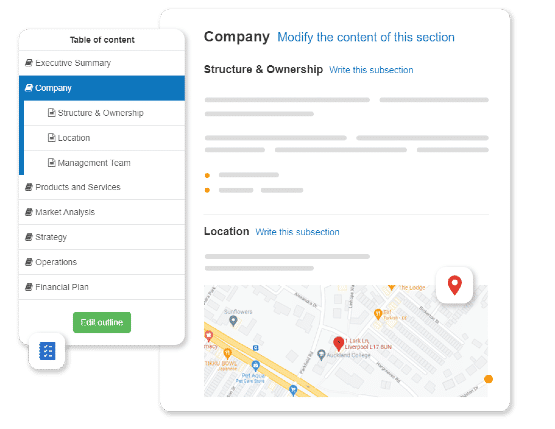
Using The Business Plan Shop to create a business plan for adonut shop has several advantages :
- You can easily create your financial forecast by letting the software take care of the financial calculations for you without errors
- You are guided through the writing process by detailed instructions and examples for each part of the plan
- You can access a library of dozens of complete startup business plan samples and templates for inspiration
- You get a professional business plan, formatted and ready to be sent to your bank or investors
- You can create scenarios to stress test your forecast's main assumptions
- You can easily track your actual financial performance against your financial forecast by importing accounting data
- You can easily update your forecast as time goes by to maintain visibility on future cash flows
- You have a friendly support team on standby to assist you when you are stuck
If you're interested in using this type of solution, you can try The Business Plan Shop for free by signing up here.
How to raise finance for my donut shop?
Once your business plan has been drafted, you’ll need to think about how you might secure the financing necessary to open your donut shop.
The amount of initial financing required will obviously depend on the size of your donut shop and the country in which you wish to set up.
Businesses have access to two main categories of financing: equity and debt. Let's take a closer look at how they work and what sources are available.
Equity funding
At a high level, the equity of your donut shop will consist of the money that founders and potential investors will invest to launch the company.
Equity is indispensable as it provides the company with a source of long-term (often permanent) financing and demonstrates the founders' conviction in the company's chances of success, since their investments would be lost in the event of bankruptcy.
Equity investors can generate a return on their investment through dividends (which can only be paid out if the company is profitable) or capital gains on the resale of their shares (if the company is attractive enough to attract a buyer).
As you can see, the equity investors' position is extremely risky, since their capital is at risk and can be lost in the event of bankruptcy, and the company must be profitable or resellable before they can hope to generate a return on their investment.
On the other hand, the return on investment that equity investors can expect to generate by investing in a donut shop can be very substantial if the company is successful.
This is why equity investors look for start-up ideas with very high growth or profitability potential, in order to offset their risk with a high potential return on investment.
In technical terms, equity includes:
- Share capital and premiums: which represent the amount invested by the shareholders. This capital is considered permanent as it is non-refundable. In return for their investment, shareholders receive shares that entitle them to information, decision-making power (voting in general assembly), and the potential to receive a portion of any dividends distributed by the company.
- Director loans: these are examples of non-permanent capital advanced to the company by the shareholders. This is a more flexible way of injecting some liquidity into your company than doing so as you can repay director loans at any time.
- Reserves: these represent the share of profits set aside to strengthen the company's equity. Allocating a percentage of your profits to the reserves can be mandatory in certain cases (legal or statutory requirement depending on the legal form of your company). Once allocated in reserves, these profits can no longer be distributed as dividends.
- Investment grants: these represent any non-refundable amounts received by the company to help it invest in long-term assets.
- Other equity: which includes the equity items which don't fit in the other categories. Mostly convertible or derivative instruments. For a small business, it is likely that you won't have any other equity items.
The main sources of equity are as follows:
- Money put into the business from the founders' personal savings.
- Money invested by private individuals, which can include business angels, friends, and family members.
- Funds raised through crowdfunding, which can take the form of either equity or donations (often in exchange for a reward).
- Government support to start-ups, for example, loans on favourable terms to help founders build up their start-up capital.
Debt funding
The other way to finance your donut shop is to borrow. From a financial point of view, the risk/return profile of debt is the opposite of that of equity: lenders' return on investment is guaranteed, but limited.
When it borrows, your company makes a contractual commitment to pay the lenders by interest, and to repay the capital borrowed according to a pre-agreed schedule.
As you can see, the lenders' return on investment is independent of whether or not the company is profitable. In fact, the only risk taken by lenders is the risk of the company going bankrupt.
To avoid this risk, lenders are very cautious, only agreeing to finance when they are convinced that the borrowing company will be able to repay them without problems.
From the point of view of the company and its stakeholders (workforce, customers, suppliers, etc.), debt increases the risk of the venture, since the company is committed to repaying the capital whether or not it is profitable. So there's a certain distrust towards heavily indebted companies.
Companies borrow in two ways:
- Against their assets: this is the most common way of borrowing. The bank finances a percentage of the price of an asset (a vehicle or a building, for example) and takes the asset as collateral. If the company cannot repay, the bank seizes the asset and sells it to limit its losses.
- Against their future cash flows: the bank reviews the company's financial forecast to estimate how much the company can comfortably borrow and repay, and what terms (amount, interest rate, term, etc.) the bank is prepared to offer given the credit risk posed by the company.
When creating a donut shop, the first option is often the only one available, as lenders are often reluctant to lend on the basis of future cash flows to a structure that has no track record.
The type of assets that can be financed using the first method is also limited. Lenders will want to be sure that they can dispose of foreclosed assets if needed, so they need to be assets that have an established second-hand market.
That being said, terms and conditions also depend on the lender: some banks are prepared to finance riskier projects, and not all have the same view of your company's credit risk. It also depends on the collateral you can offer to reduce risk, and on your relationship with the bank.
In terms of possible sources of borrowing, the main sources here are banks and credit institutions.
In some countries, it's also possible to borrow from private investors (directly or via crowdlending platforms) or other companies, but not everywhere.
Takeaways on how to finance a donut shop
Multiple options are available to help you raise the initial financing you need to launch your donut shop.
There are two types of financing available to companies. To open a donut shop, an equity investment will be required and may be supplemented by bank financing.
What to do after launching my donut shop?
Launching your donut shop is the beginning of an exciting entrepreneurial adventure, and the culmination of your efforts to turn your idea into a reality. But this is also when the real work begins.
As you know, nearly half of all new businesses fail, so you'll need to do everything you can to make your business sustainable right from the start.
Estimating the future financial performance of a donut shop inevitably involves a degree of uncertainty. That's why we recommend simulating several scenarios: a central case with the most likely scenario, an optimistic case, and a pessimistic case designed to test the limits of your business model.
Normally, your company's actual financial performance, observed after you start trading, should fall somewhere between your pessimistic and optimistic cases.
The important thing will be to quickly measure and compare this actual performance with the figures in your forecast to see where you stand, then update the forecast to re-estimate the future cash flows and cash position of your donut shop.
This forward-looking financial management exercise is the only way to know where you stand and where you're going. And, when your figures fall short of expectations, to quickly implement actions to turn things around before the company runs out of cash.
There's nothing more dangerous than waiting until you have your accounts, which takes up to nine months after the end of your financial year (if you are in the UK, abroad your mileage will vary), to then realize that you're not on the right track and that your donut shop won't have enough cash to operate over the next twelve months.
This is where using a forecasting solution that integrates actuals vs. forecast tracking, like The Business Plan Shop's financial dashboards do, can simplify the financial management of your business and help reduce the risk associated with your start-up project.
Key takeaways
- There are 15 key steps to opening a donut shop.
- Your financial forecast will enable you to accurately assess your initial financing requirements and the potential profitability of your project.
- Your business plan will give your financial partners the context they need to be able to judge the consistency and relevance of your forecast before deciding whether or not to finance the creation of your donut shop.
- Post-launch, it's essential to have an up-to-date forecast to maintain visibility of your business's future cash flows.
- Using a financial planning and analysis platform that integrates forecasts, business plans and actual performance monitoring, such as The Business Plan Shop, makes the process easier and reduces the risks involved in starting a business.
We hope this guide has helped you understand how to open a donut shop. Please don't hesitate to contact us if you have any questions or want to share your experience as an entrepreneur.
Also on The Business Plan Shop
Know someone who wants to start a donut shop? Share this guide with them!
